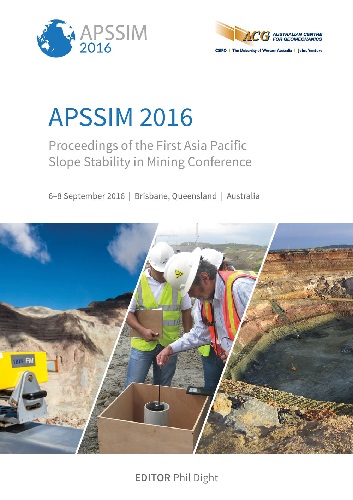Estimation of in situ strength from back-analysis of pit slope failure

|
Authors: Brown, IR; Wood, PJ; Elmouttie, MK |
DOI https://doi.org/10.36487/ACG_rep/1604_18_Brown
Cite As:
Brown, IR, Wood, PJ & Elmouttie, MK 2016, 'Estimation of in situ strength from back-analysis of pit slope failure', in PM Dight (ed.), APSSIM 2016: Proceedings of the First Asia Pacific Slope Stability in Mining Conference, Australian Centre for Geomechanics, Perth, pp. 331-338, https://doi.org/10.36487/ACG_rep/1604_18_Brown
Abstract:
Using a software package that can be used for either three or two-dimensional (2D) slope stability analyses of the same model we analyse the stability of columns (3D) or slices (2D) overlying a shear failure surface. The failure surface can be any shape, such as that formed by interconnecting fault surfaces in an open pit slope failure that we analyse. We show that there is a significant difference in the factors of safety calculated using 3D analyses, compared with 2D sections through the same model. This means that different shear strength parameters will apply when the values are varied to obtain a Factor of Safety of 1.0. Systematic back-calculations of open pit slope failures using appropriate 3D analysis methods can give a better understanding of appropriate shear strengths to use in forward 3D analyses. This should lead to more efficient pit slope designs.
Keywords: back analysis, 3D stability, computer model
References:
ARANZ Geo 2016, www.leapfrog3d.com
Chapple, AP 1998, ‘An engineering geological investigation into pit slope stability at Macraes Gold Mine, Macraes Flat, Otago, New Zealand’, unpublished MSc thesis, University of Canterbury.
Duncan, JM, Wright, SG & Brandon, TL 2014, Soil strength and slope stability, John Wiley & Sons, Inc.
Elmouttie, M, Krahenbuhl, G & Soliman, A 2016, ‘A new excavation analysis method for slope design using discrete fracture network based polyhedral modelling’, Computers and Geotechnics, vol. 76, pp. 93–104.
Elmouttie, M, Poropat, G, & Krahenbuhl, G 2010, ‘Polyhedral modelling of rock mass structure’, International Journal of Rock Mechanics & Mining Science, vol. 47, pp. 544–552.
Jing, L 2000, ‘Block system construction for three-dimensional discrete element models of fractured rocks’, International Journal of Rock Mechanics & Mining Science, vol. 37, pp. 645–659.
Jing, L & Stephansson, O 1994, ‘Topological identification of block assemblages for jointed rock masses’, International Journal of Rock Mechanics & Mining Science and Geomechanics Abstracts, vol. 31, pp. 163–172.
Lee, MC, Batt, WD & Robinson, PC 1989, ‘The Round Hill gold-scheelite deposit, Macraes Flat, Otago, New Zealand’, in Mineral Deposits of New Zealand, The Gordon J. Williams Memorial Volume Monograph 13, The Australasian Institute of Mining and Metallurgy, pp 173–179.
Lin, D, Fairhurst, C & Starfield, A 1987, ‘Geometrical identification of three dimensional rock block systems using topological techniques’, International Journal of Rock Mechanics & Mining Science and Geomechanics Abstracts, vol. 26, no. 6, pp. 331–338.
Lu, J 2002, ‘Systematic identification of polyhedral rock blocks with arbitrary joints and faults’, Computers and Geotechnics, vol. 29, pp. 49–72.
Sancio, RT 1981, ‘The use of back-calculations to obtain the shear and tensile strength of weathered rocks’, in Proceedings of the International Symposium on Weak Rock, Tokyo, A.A.Balkema, Rotterdam, pp. 647–652.
Spencer, E 1967, ‘A method of analysis of the stability of embankments assuming parallel inter-slice forces’, Geotechnique, vol. 17, no. 1, pp. 11–26.
TAGAsoft 2016, www.tagasoft.com
Warburton, PM 1981, ‘Vector stability analysis of an arbitrary polyhedral rock block with any number of free faces’, International Journal of Rock Mechanics & Mining Science, vol. 18, no. 5, pp. 415–442.
© Copyright 2025, Australian Centre for Geomechanics (ACG), The University of Western Australia. All rights reserved.
View copyright/legal information
Please direct any queries or error reports to repository-acg@uwa.edu.au
View copyright/legal information
Please direct any queries or error reports to repository-acg@uwa.edu.au